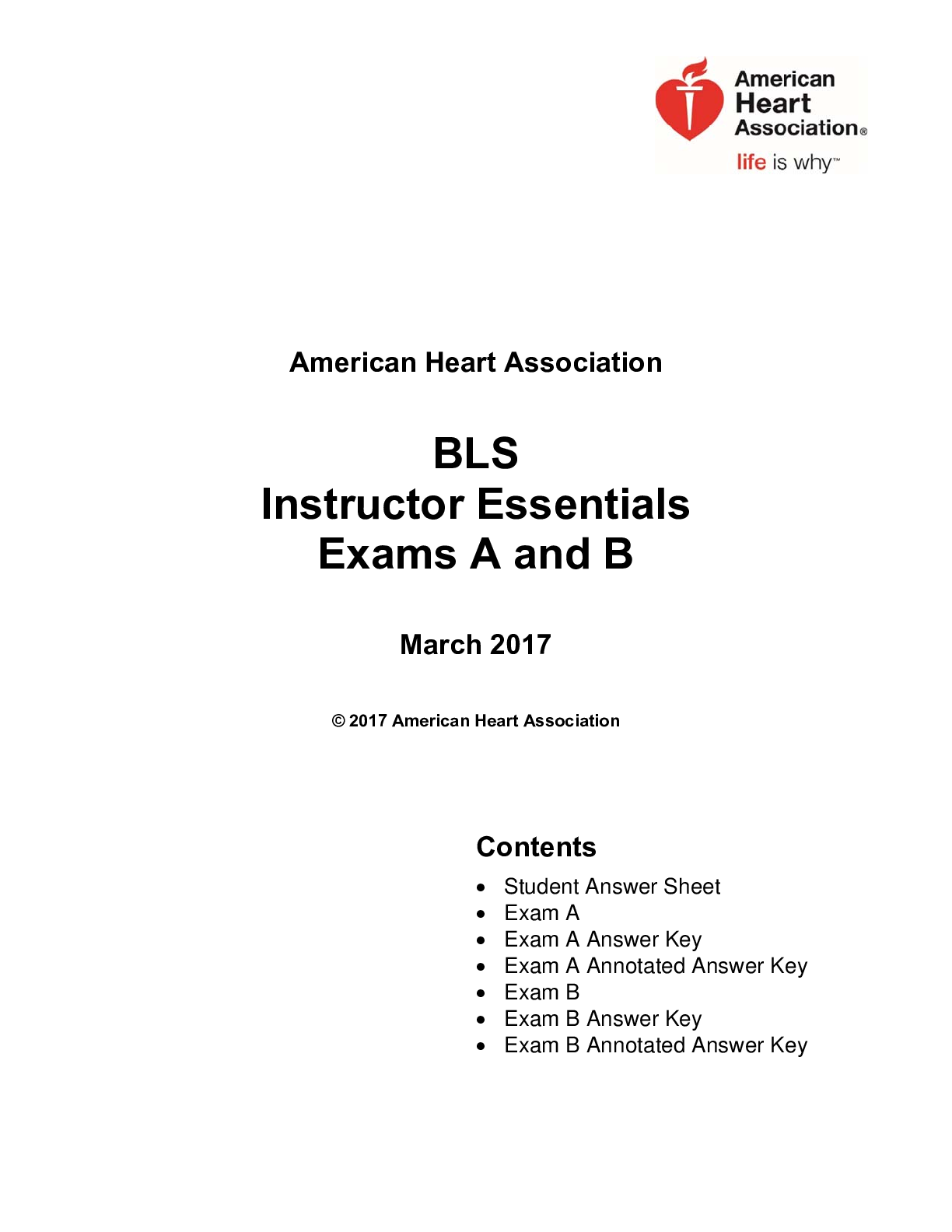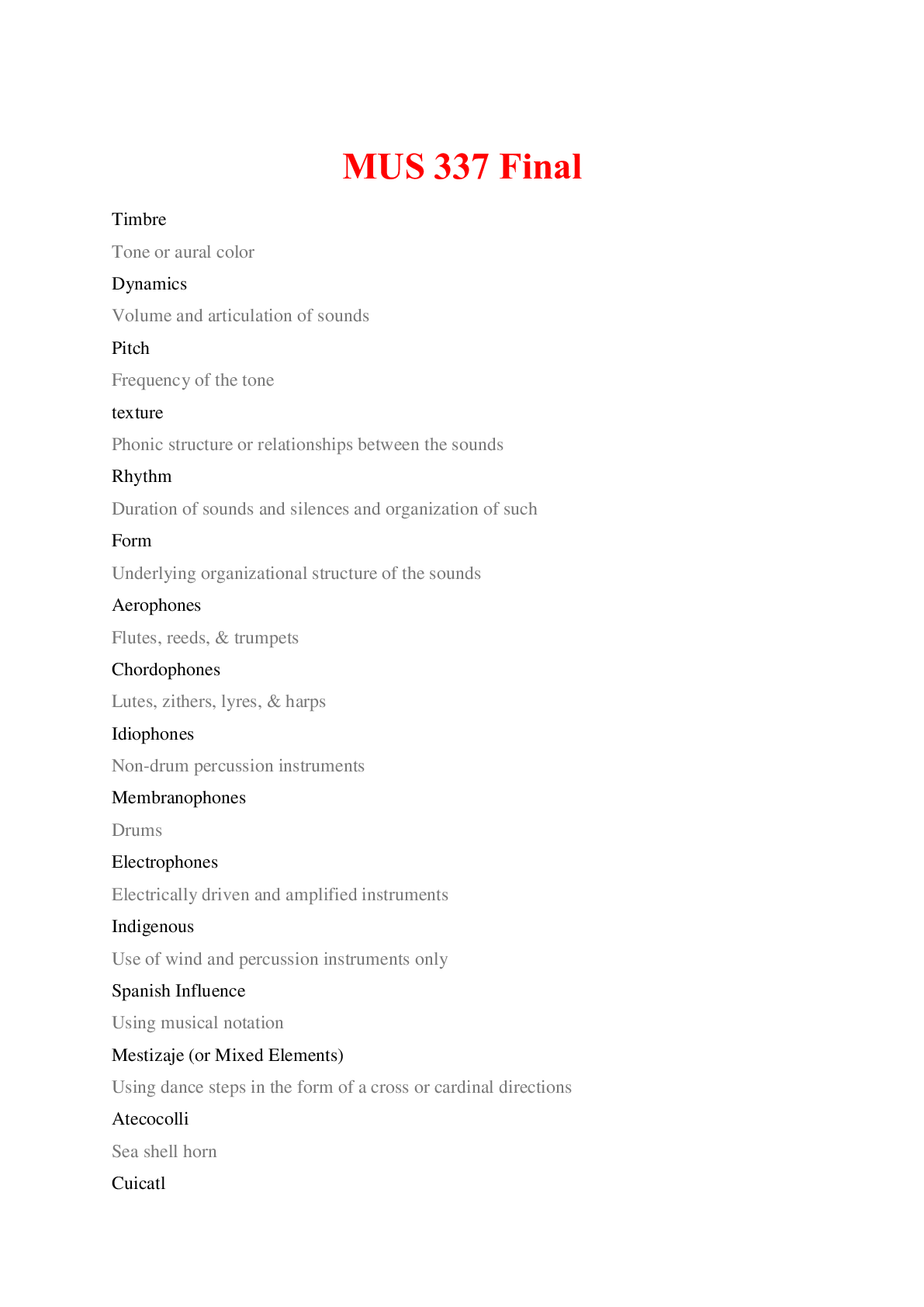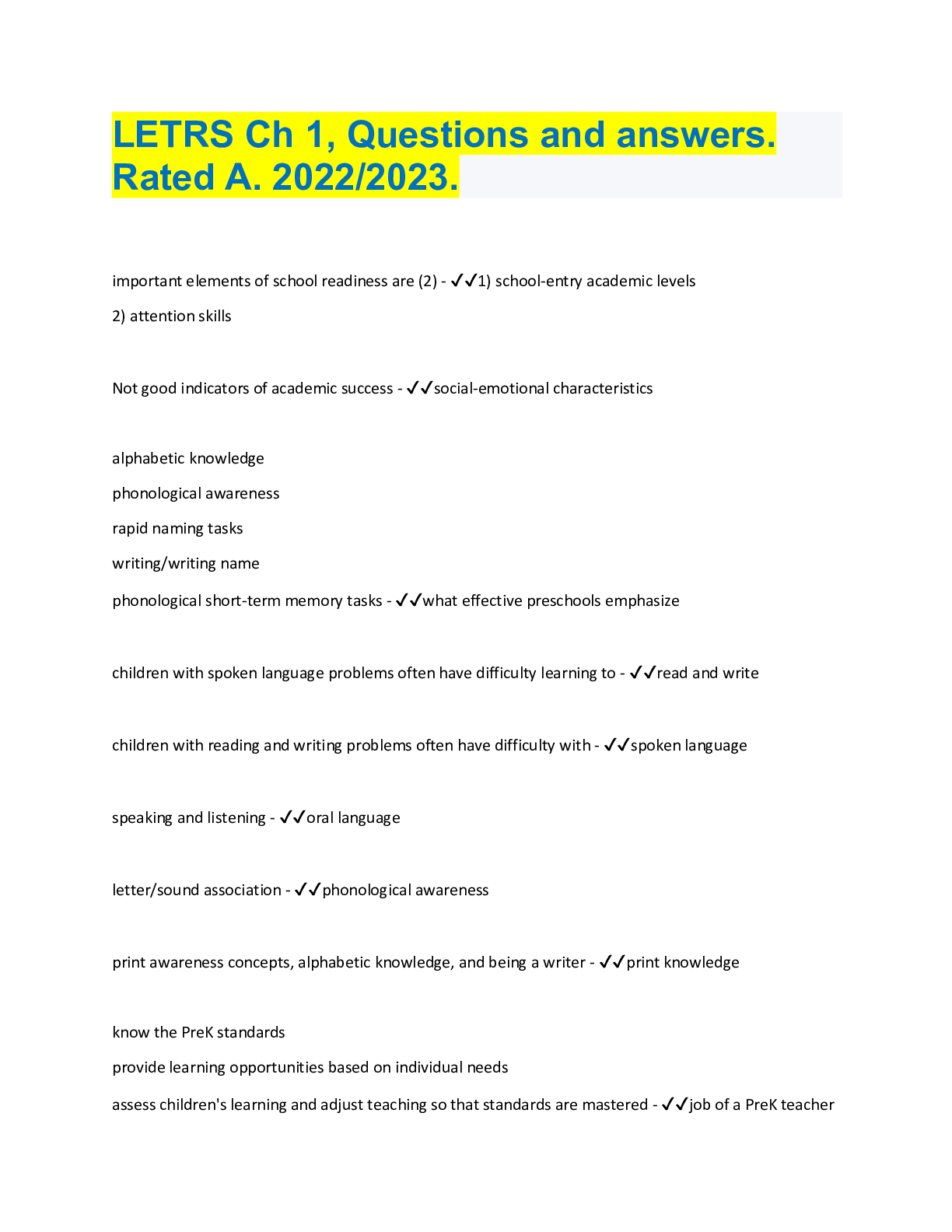Philosophy > QUESTIONS & ANSWERS > PHI_103 Week 3 Quiz -Questions with Answers (All)
PHI_103 Week 3 Quiz -Questions with Answers
Document Content and Description Below
Question : What type of inductive argument is the following example? Every Eagles record I have heard has been great, so probably all of their albums are great. Student Answer: Argument from anal... ogy Inductive generalization Statistical syllogism Inference to the best explanation Instructor Explanation: The answer can be found in Section 5.3, “Statistical Arguments: Inductive Generalizations,” of With Good Reason: A Guide to Critical Thinking. Points Received: 1 of 1 Comments: Question 2 . Question : This is the term that one uses to describe a sample that aligns well with the larger group one is studying. Student Answer: Valid Statistical Representative Skewed Instructor Explanation: The answer can be found in Section 5.3, “Statistical Arguments: Inductive Generalizations,” of With Good Reason: A Guide to Critical Thinking. Points Received: 0 of 1 Comments: Question 3 . Question : Which of the following is a necessary condition for survival? Student Answer: The presence of grass The presence of oxygen The presence of art Enjoying one’s job Instructor Explanation: The answer can be found in Section 5.4, “Causal Relationships: The Meaning of Cause,” of With Good Reason: A Guide to Critical Thinking. Points Received: 1 of 1 Comments: Question 4 . Question : A claim is falsifiable if __________. Student Answer: we know how one could show it to be false we know how one could show it to be true we cannot determine a way to prove it false we can determine a way to see if it is true or false Instructor Explanation: The answer can be found in Section 6.4, “Reasoning About Science: The Hypothetico–Deductive Method,” of With Good Reason: A Guide to Critical Thinking. Points Received: 0 of 1 Comments: Question 5 . Question : The acceptable confidence level for an analysis or experiment __________. Student Answer: is the same across all fields does not change based on what one is trying to determine is more important for celebrities than for others is often more than 90% in academic analyses Instructor Explanation: The answer can be found in Section 5.3, “Statistical Arguments: Inductive Generalizations,” of With Good Reason: A Guide to Critical Thinking. Points Received: 1 of 1 Comments: Question 6 . Question : Mill’s methods claim that when there is a phenomenon or event that is regularly correlated with another phenomenon or event, then the two events or phenomena may be causally connected. Which of Mill’s methods does this describe? Student Answer: Method of agreement Method of difference Joint method of agreement and difference Method of concomitant variation Instructor Explanation: The answer can be found in Section 5.5, “Causal Arguments: Mill’s Methods,” of With Good Reason: A Guide to Critical Thinking. Points Received: 0 of 1 Comments: Question 7 . Question : Good explanations often can explain other phenomena. The name for this is __________. Student Answer: explanatory power fecundity testability falsifiability Instructor Explanation: The answer can be found in Section 6.5, “Inference to the Best Explanation,” of With Good Reason: A Guide to Critical Thinking. Points Received: 1 of 1 Comments: Question 8 . Question : This is a method by which one can strengthen an inductive argument. Student Answer: Adding false supporting premises Demonstrating that the argument is valid Adding supporting premises Inductive arguments cannot be strengthened Instructor Explanation: The answer can be found in Section 6.1, “Contrasting Deduction and Induction,” of With Good Reason: A Guide to Critical Thinking. Points Received: 1 of 1 Comments: Question 9 . Question : Inference to the best explanation is often expressed in which invalid argumentative form? Student Answer: Denying the antecedent Affirming the consequent Denying the consequent Affirming the antecedent Instructor Explanation: The answer can be found in Section 6.5, “Inference to the Best Explanation,” of With Good Reason: A Guide to Critical Thinking. Points Received: 1 of 1 Comments: Question 10 . Question : This form of argument is an inductive form that reasons from the general to the specific. Student Answer: Modus ponens Statistical syllogism Hypothetical syllogism Inductive generalization Instructor Explanation: The answer can be found in Section 6.1, “Contrasting Deduction and Induction,” of With Good Reason: A Guide to Critical Thinking. Points Received: 1 of 1 Comments: Question 11 . Question : Consider the following argument. It rained today. It is going to rain tomorrow. Which of the following would make this argument stronger? Student Answer: Evidence that the atmospheric conditions tomorrow will be the same Asking one’s friends if they think it is going to rain Turning the argument into a deductive argument about the weather Consulting someone who reads tea leaves and asking what he or she believes Instructor Explanation: The answer can be found in Section 5.1, “Basic Concepts in Inductive Reasoning,” of With Good Reason: A Guide to Critical Thinking. Points Received: 1 of 1 Comments: Question 12 . Question : Inductive arguments are preferable in some instances because they __________. Student Answer: are not as available are more limited than deductive arguments can be more persuasive have more truth Instructor Explanation: The answer can be found in Section 6.2, “Choosing Between Induction and Deduction,” of With Good Reason: A Guide to Critical Thinking. Points Received: 1 of 1 Comments: Question 13 . Question : Which of the following is an example of an inverse correlation? Student Answer: The longer you study, the better your grades get. The taller you grow, the more you weigh. The lower your water intake, the higher your blood salt levels. The relationship between you and your inlaws. Instructor Explanation: The answer can be found in Section 5.4, “Causal Relationships: The Meaning of Cause,” of With Good Reason: A Guide to Critical Thinking. Points Received: 1 of 1 Comments: Question 14 . Question : If A is a sufficient condition for B, then which relationship holds between them? Student Answer: Whenever A occurs, B occurs. Whenever B occurs, A occurs. A and B neve [Show More]
Last updated: 1 year ago
Preview 1 out of 11 pages

Reviews( 0 )
Document information
Connected school, study & course
About the document
Uploaded On
Apr 28, 2022
Number of pages
11
Written in
Additional information
This document has been written for:
Uploaded
Apr 28, 2022
Downloads
0
Views
79

.png)
.png)
.png)
.png)
.png)
.png)
.png)
.png)
.png)
.png)
.png)

.png)

.png)
.png)














